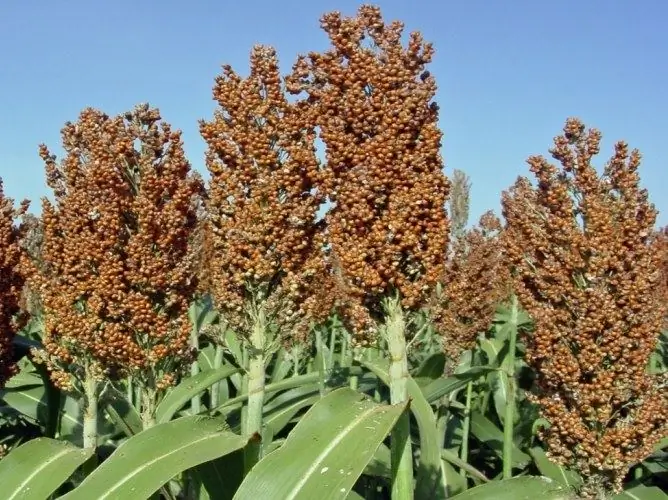- Author Nora Macey [email protected].
- Public 2023-12-16 10:17.
- Last modified 2025-01-23 08:47.
In the world there are many cereals used for food production, as well as used for domestic purposes. One of them is sorghum. This peculiar and in its own way unique cereal was known to the peoples of southern countries long before the onset of a new era.

Types and uses of sorghum
Sorghum is a genus of perennial or annual herbaceous plants of the family of cereals and is considered the main grain crop in some countries of the world. Outwardly, the grains of this plant are somewhat reminiscent of corn, and in terms of nutritional properties they are in no way inferior to it. Sorghum grains are used to produce alcohol, starch, flour and cereals. Honey and syrup are obtained from the stems of such a culture, brooms and paper are made from straw, and a variety of products are also weaved.
A thermophilic cross-pollinated spring crop, it is highly drought tolerant. It quickly adapts to adverse conditions and grows on almost any soil, including saline soils. Sorghum has a growing season of about 130 days.
The classification of sorghum varieties is far from complete, as this plant has an incredible number of species.
Distinguish between sugar sorghum, which is used in the confectionery industry; grain sorghum, which is bred for flour; lemon sorghum, which, after processing, becomes a unique seasoning. Herbaceous varieties are grown to feed livestock. There are also hard-twisted sorghums that are good for making wickerwork and brooms.
Sorghum: interesting facts
The homeland of sorghum is considered to be Central and Northeast Africa. Even in antiquity, this plant occupied significant areas in Sudan and Ethiopia. The largest number of both wild and cultivated varieties of sorghum can be found there today. This plant is also cultivated in India and China. In these countries, sorghum is the main grain used in the preparation of bread products.
This culture came to Europe and America relatively late - after the 15th century. Today, about fifty species of sorghum are grown on all continents. Such a cereal is cultivated, as a rule, in southern and warm regions. It is also represented in the steppe zone of Russia and Ukraine.
Growing sorghum is not too difficult, although it does take some skill. It is only necessary to take into account that such a plant takes root best of all in places where the summer is hot and there is not too much rainfall.
In cool areas, sowing sorghum is recommended as late as possible, since the crop does not tolerate frost on the soil very well.
Sorghum hates the neighborhood of weeds, and therefore needs careful and timely weeding and thinning. This is especially true for those varieties that are grown for the manufacture of wicker products and brooms. If the plant is not thinned out in time and is not freed from weeds, a too underdeveloped and small "panicle" will be formed.


